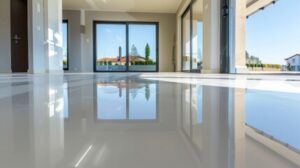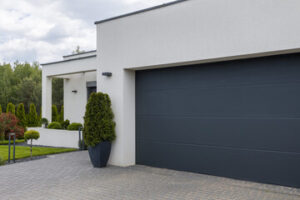Nashville Epoxy Flooring is water-resistant, making them perfect for industrial spaces that may be prone to flooding. They are also resistant to most chemical spills, such as oil, gasoline, bleach, and transmission fluid.

Epoxy floor coatings also feature traction-enhancing elements, increasing workplace safety and minimizing slip-and-fall incidents. This makes them ideal for garages and other commercial environments that need durable flooring.
Epoxy flooring offers one of the most durable floor coatings on the market. It is also stain-resistant, chemical-proof and aberration-proof – making it an excellent choice for harsh environments where a tough floor is required.
Before an epoxy coating can be installed, the concrete floor needs to be thoroughly cleaned and degreased to remove any contaminates that could interfere with the bonding process. In addition, any cracks or chips in the surface must be repaired to ensure a strong and long-lasting coating.
Once the preparation work is complete, a primer can be applied to help the epoxy adhere better to the concrete floor. Then, the resin and hardener are mixed together according to the manufacturer’s instructions. Once everything is ready, the epoxy is rolled onto the floor and allowed to cure for several days. The result is a solid and smooth coating that can stand up to the rigours of commercial, industrial and residential use.
In retail buildings like department stores, concrete floors endure a lot of foot traffic and the weight of shelving. They also have to be hygienic and slip-resistant. A Novolac epoxy coating can withstand these demands and lasts for up to 15 years in this type of environment.
Manufacturing and warehouses have similar demands on their floors, but they must also be able to withstand the pressure of heavy machinery like forklifts. This can reduce the lifespan of an epoxy floor coating, but if it is properly maintained, it can last up to 15 years.
While it is rare, epoxy can scuff or scratch if the concrete substrate under the floor is water-affected, damaged or compromised in any way. It is important to inspect the concrete under the epoxy regularly to avoid these issues, and to take measures like adding furniture pads to prevent scratches, or using clear PU topcoats that offer greater scuff resistance.
Regular maintenance practices like sweeping, mopping with mild detergents and occasional resealing will help to extend the lifespan of an epoxy floor. By following these simple steps, you can get the most from your investment and have a floor that continues to perform in even the harshest of conditions.
Light Reflection
One of the most appealing aspects of epoxy floor coatings is their ability to reflect light. The coating creates a bright, airy look that can make a small room feel much larger. This effect is enhanced by choosing lighter colors and using reflective wall accents, such as glass or mirrors.
Epoxy floors also offer a range of aesthetic options, including unique textures and patterns. These designs can help a business to showcase its personality and reinforce brand identity. In addition, a wide variety of color options allows for customization to fit individual needs. For example, companies can choose to add safety color markings that align with specific hazard warnings and comply with industry standards.
Another advantage of epoxy floor coating is its chemical and stain resistance. This feature is especially useful in warehouses and manufacturing environments, where spills of chemicals, oils, and other liquids are commonplace. The non-porous nature of epoxy makes it an ideal choice for containing these spills, minimizing damage to the floor and reducing maintenance costs.
In addition, epoxy is resistant to UV rays, which can cause fading in other flooring materials. This prevents the yellowing that can occur in some other types of flooring, making it an excellent long-term option for commercial and residential spaces. Finally, epoxy coatings are odor-free and do not emit harmful fumes like those found in urethane products.
A professional epoxy floor installer can recommend the best type of coating for your environment. They will first prepare the concrete surface by testing it for previous applications, sanding it down with equipment like a 25 grit metal diamond pad, and addressing any cracks or joints. This ensures optimum adherence of the epoxy coating and a smooth finish.
Then, they will apply multiple coats of epoxy to create a durable and beautiful finish. Once the epoxy dries, it is sealed with a topcoat to protect the surface and give it a glossy shine. Polyurethane is a popular topcoat for industrial epoxy floors because it resists scratching, stains, and is anti-fungal. It also offers a high degree of durability and is easy to clean.
Easy Maintenance
Epoxy flooring is a great option for any commercial or industrial environment, as it’s both durable and easy to maintain. It can withstand heavy foot traffic daily, resulting in less damage to the surface than traditional floor coatings like tiles or carpeting. Additionally, epoxy is extremely easy to clean and sanitize — which can be crucial for high-traffic areas such as pools and public restrooms where bacteria and fungi tend to grow rapidly.
Regular sweeping or dust mopping is enough to keep the epoxy surface free of dirt, sand particles, and other gritty contaminants that can scratch or etch the coating over time. This cleaning should be done daily in high-traffic areas and at least weekly in other environments. Sweeping the flooring also helps to avoid stains by keeping the area as dry as possible.
Spills should be cleaned up as soon as they occur, as they will stain or damage the epoxy if left unattended. The liquid can be removed with a shop vac or by blotting the area and then wiping down with a soft sponge. In the case of chemical spills, a mild detergent or pH-neutral cleaner diluted with water can be used to clean the area. The mopping should be accompanied by a thorough rinse to ensure that all the soapy residue is removed and not left behind on the floor.
In addition to the regular maintenance, you can help your epoxy floors last longer by putting down walk-off mats at all entrances of your building. These mats will collect dirt, sand and moisture before it gets tracked on the floor, helping to prevent scratches and scuffs. You should also put down pads under the feet of any equipment or machinery that will be placed on your floors, such as a welder or motorcycle stand.
Before an epoxy floor can be installed, the concrete needs to be thoroughly inspected and cleaned. If the concrete is too damaged or contaminated, it will not be able to support an epoxy floor coating and could crack or chip underneath. The concrete will also need to be prepped for the installation process, which can include grinding or shot blasting to create a smooth and even surface. The resin and hardener will then need to be mixed and applied to the floor according to the manufacturer’s instructions.
Customization
The customization capabilities of epoxy flooring are endless, making it a top choice for homeowners seeking to elevate their living spaces. Its sleek appearance and high-performance qualities make it a popular flooring option for garages, retail spaces, warehouses, and even kitchens. It’s also a great choice for basements, as it creates a clean and vibrant space that’s moisture-resistant.
Epoxy floor coatings are available in a variety of color options, allowing homeowners to choose hues that match their design themes. Grey base coats offer a neutral and versatile foundation that complements various decor styles, while white or beige floor coatings enhance light reflection and provide a crisp environment. These colors can also be customized with textured finishes for added slip resistance.
Additionally, homeowners can add a unique touch to their floors by mixing in materials such as quartz, metallic flakes, and decorative aggregates. These materials can be mixed into the epoxy resin before application to achieve desired effects and textures. For example, adding aggregate sand blends can create thicker flooring systems and add non-slip texture, while using metallic flakes can create a dazzling, reflective surface that enhances the look of any room.
In commercial spaces, epoxy is a cost-effective and durable solution that helps create a welcoming atmosphere for visitors and customers. Its customizable designs and vivid colors allow businesses to showcase their brand and set the tone of the space. For instance, a company’s logo can be embedded into the epoxy coating to create a one-of-a-kind floor that reflects its branding.
Epoxy flooring is extremely durable and highly resistant to stains, chemicals, and impact damage, making it ideal for high-traffic areas. In addition, the seamless surface eliminates grout lines where dirt and allergens can accumulate, making it easy to clean. However, it is important to keep in mind that epoxy floors may scuff and scratch if exposed to heavy traffic and dropped objects. To minimize this, it is recommended to use a clear PU topcoat with greater scuff and scratch resistance.
Epoxy floors are also a great option for industrial environments because of their durability and safety features. They are designed to resist chemical and solvent damage, as well as impact from machinery. They also feature a non-slip surface, which is essential for workplace safety. This type of flooring can be further enhanced with traction-enhancing materials such as gravel, aluminum oxide, or polymer grit.
